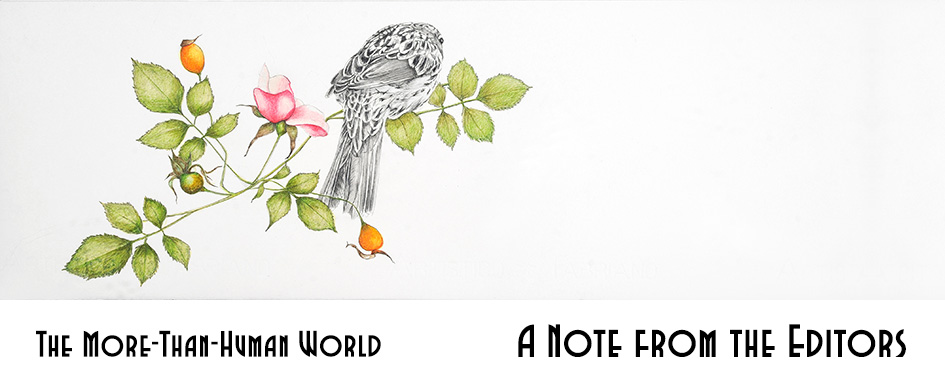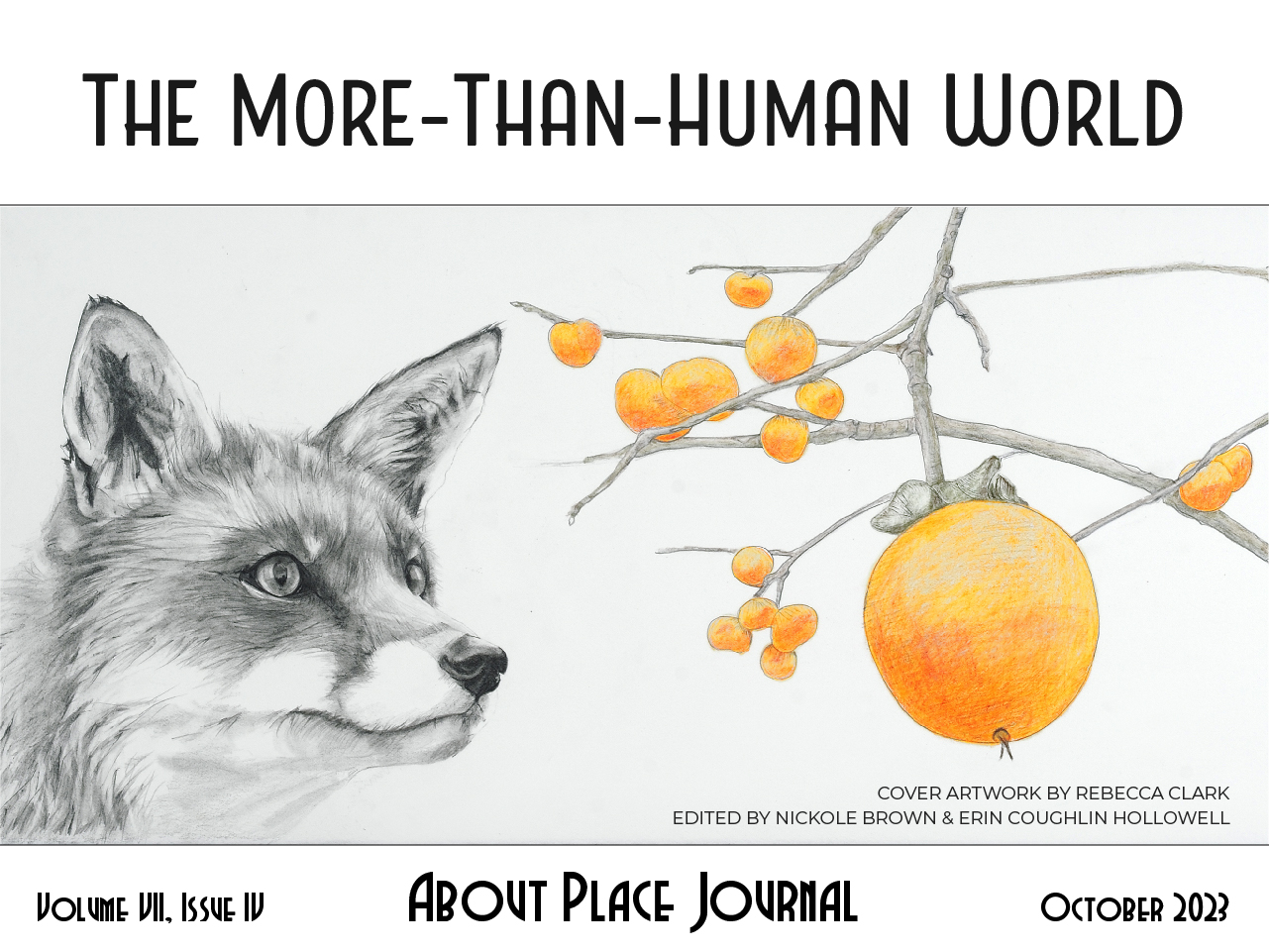Some decisions are easy to make. Like when as fellows of the Black Earth Institute we were charged with co-editing this issue of About Place Journal and were asked what we’d like the theme to be.
It took the two of us all of two minutes to decide, because both of us are downright obsessed with life, particularly all those trees we walk under every chance we get, all those mushrooms and ants roiling up through the soil beneath our feet, and of course, the animals—all of them—furred and finned and feathered—that delight and enchant us daily. All creatures, so to speak, great and small.
Take, for example, Nickole’s life in Asheville, North Carolina—when she’s not hunched over her desk, she pulls on her muck boots and heads to the fields and barns where she lends a hand at several sanctuaries around town. She finds the ears of donkeys to be sacred and has whispered more than one story into them, and she never quite stops trying to find the words to describe her favorite smell, which is that green, dust-dry, salt scent rising from under a horse’s mane.
And Erin? Well, she makes her home in Homer, Alaska, where she’s enchanted by crows and birch trees and the creatures of the wrack line. You can find her at her holy place on Bishop’s Beach every Sunday, listening to the conversations between whatever has wings and the waves. And in the evenings, when she’s not out with the owls, she’ll be trying to incorporate all the voices of the vast wilderness as it wheels around her into her work.
So, needless to say, what binds this issue of About Place is an abiding love for plants and animals and insects. But we also wanted to use this platform to try rectify something that has bothered both of us for some time, and that is the way the vast majority write about this topic, holding humans as separate and above.
It has, no doubt, been this way for a long while, at least for most of western, colonial history, so much so that few even take notice. And it’s no exaggeration to say that the representation of non-human life in literature parallels the treatment of those beings in real life, meaning we have used plants and animals just as we’ve seen fit, generally for our profit and consumption. And in literature, they’re generally parceled out in likeminded ways—as metaphors for our own emotions, for example, often anthropomorphized into a cartoon-like replicas of ourselves or else depicted as two-dimensional props, as background figures denied their own sentience and emotion.
What we felt was missing was work that regarded the individual realities of plants and animals and insects, both separate from but inextricably entwined with our own. It’s why, among other reasons, we refer to these beings as our more-than-human kin, because while they are other than us, they are, in many ways, more than us as well. And as an evolutionary fact, they are our kin, bound to us, as we are bound to them.
Thus, when we put out the call for submissions, we tasked writers to decenter themselves, to abandon the typical anthropocentric point of view to create stories, poems, essays, and visual art that depicted our more-than-human kin as fully formed, each being entirely complex and individual in a way we could only begin to understand.
We were skeptical at first as to what the response might be. But how wrong we were! You can imagine how moved we were to witness an outpouring of submissions—over 900 individuals sent in their work—confirming for us over and over that there were people out there—and a lot of people—who felt the same way we did.
We are delighted to share with you here just a fraction of our finds. We hope when you read this issue you’ll feel as we do—by turns surprised and elated as each piece takes its own unique approach to this formidable challenge. And we hope that you, too, may learn as much as we did, not only about the biology and predicament of individual species but also about their possible inner lives.
Most importantly, each of the contributors here seeks to not just write about the more-than-human world but for them, seeking to accurately depict their struggles and joys by fostering a literature (and even literacy) of more-than-human beings. We feel these efforts are deeply healing and necessary, especially in our over-developed, climate-changed world in which so many lives are in peril, both human and not.
We’re thankful not only to these intrepid, creative minds but also to Michael McDermott and Jesse Hughes for their assistance in guiding and formatting these pages. In addition, we want to thank our three Assistant Editors—Athene Dilke, Michelle Seaman, and Jen Stever—who not only helped us get word out about the call for submissions but sorted through such an unexpected extraordinary amount of work. The choices we had to make here were difficult, but what an embarrassment of riches.
We won’t keep you any longer by describing an experience that you can have by spending time with the work linked below. And we won’t choose favorites either by telling you which pieces stood out to us and why. In truth, each of these selections does something entirely unique, and put together, the collection will make your world larger, richer, and more diverse.
As Robin Wall Kimmerer writes, “Maybe now, in this time when the myth of human exceptionalism has proven illusory, we will listen to intelligences other than our own, to kin. To get there, we may all need a new language to help us honor and be open to the beings who will teach us.”
All good things,
Nickole Brown & Erin Coughlin Hollowell




